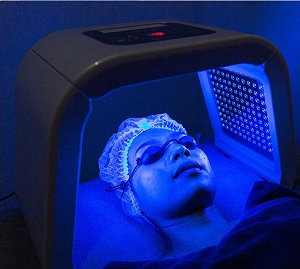Photodynamic therapy (PDT) is a medical treatment that utilizes a photosensitizing agent and a specific wavelength of light to selectively target and destroy abnormal cells or tissues. It is commonly used in dermatology to treat various skin conditions, including certain types of cancer, precancerous lesions, acne, and photodamage. Here are some key points about photodynamic therapy:
Procedure: The photodynamic therapy process involves several steps:
Application of a photosensitizing agent: A photosensitizing agent, usually a topical medication called a photosensitizer, is applied to the skin. This agent is absorbed by the abnormal cells or tissues being targeted.
Incubation period: After the photosensitizer is applied, it needs time to be absorbed by the targeted cells. The incubation period typically lasts anywhere from 30 minutes to a few hours, depending on the specific photosensitizer used.
Activation with light: Once the incubation period is complete, the targeted area is exposed to a specific wavelength of light. The light activates the photosensitizer, leading to the production of reactive oxygen species that selectively destroy the abnormal cells or tissues.
Applications of Photodynamic Therapy:
Skin cancer: PDT can be used to treat certain types of non-melanoma skin cancers, such as basal cell carcinoma and squamous cell carcinoma. It is particularly useful for treating superficial skin cancers or pre-cancerous lesions known as actinic keratoses.
Acne: PDT can be effective in managing moderate to severe acne. The light and photosensitizer combination helps to reduce the production of oil, destroy acne-causing bacteria, and shrink sebaceous glands.
Photodamage and precancerous lesions: PDT can improve the appearance of sun-damaged skin, minimize fine lines and wrinkles, and treat precancerous lesions like actinic keratoses.
Advantages of Photodynamic Therapy:
Selective targeting: PDT selectively targets abnormal cells or tissues while sparing surrounding healthy cells.
Non-invasive: The procedure is generally non-invasive and does not require surgical intervention.
Cosmetic benefits: In addition to treating medical conditions, PDT can improve the overall appearance and texture of the skin, resulting in a more youthful and rejuvenated complexion.
Side Effects and Aftercare: Side effects of photodynamic therapy may include temporary redness, swelling, and peeling of the treated area. Sensitivity to sunlight can also occur, so it’s important to protect the treated skin from direct sun exposure and follow the aftercare instructions provided by your healthcare provider.
Photodynamic therapy is a specialized procedure that requires the expertise of a dermatologist or healthcare professional. They will assess your specific condition, determine if PDT is appropriate for you, and guide you through the treatment process. They can also provide information on the number of sessions needed and any potential risks or complications associated with the procedure.
Tailored Solutions for Beautiful Skin
Achieving beautiful and healthy skin starts with personalized care. Our clinic offers tailored solutions for a wide range of skin concerns, including acne, aging, dryness, and more. Our team of knowledgeable dermatologists will work closely with you to understand your specific goals and develop a customized treatment plan. From targeted skincare products to specialized procedures, we provide comprehensive solutions to help you achieve the radiant and flawless skin you deserve.

